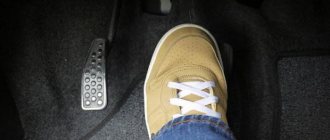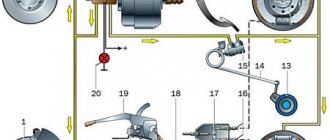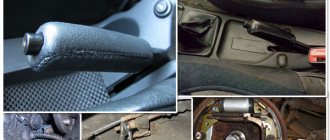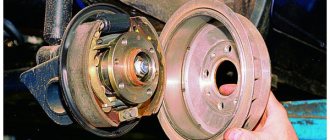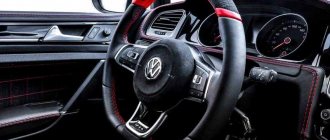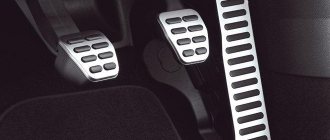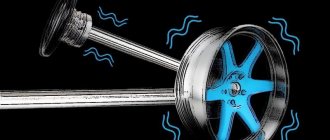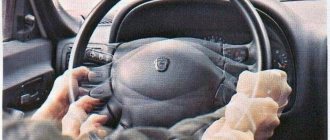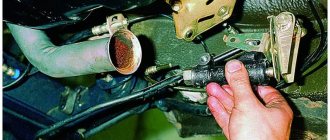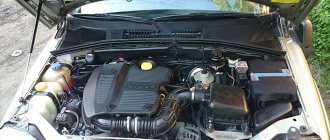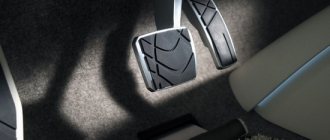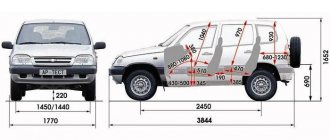The braking system is one of the main components of a car, which allows you to respond in a timely manner to obstacles while moving in traffic without causing emergency situations. A slow response to pressing the pedal can cause a collision with the car in front, and too sharp a response will interfere with cars behind. And in general, any malfunction in the brake system invariably leads to a decrease in pedal response time, the driver cannot predict the movement of the car and the chance of getting into an accident increases sharply. One of the manifestations of a malfunction in the brake system may be that the Chevrolet Niva brake pedal hits when braking. If this problem occurs, you should immediately diagnose the brake system and fix the problem.
Where does steering wheel wobble come from?
Steering wheel beating at the moment of braking means spontaneous jerking of the steering wheel in different directions.
In especially advanced cases, the vibration is so strong that the driver has to literally catch the car on the road. At speeds above 50 km/h, the phenomenon creates a real danger for vehicle passengers. Since the steering wheel is rigidly connected to the front wheel hubs through a rack and ball ends, the source of the problem must be sought in the chassis and braking system of the car. The main causes of strong vibration lie in various defects of the brake disc:
- the working part of the product is deformed and has a wavy surface;
- due to the impact, the disk was damaged and cracked;
- The spare part was originally defective or installed incorrectly.
It is no coincidence that the front brake discs are named as the culprits. As soon as the working surface of the part changes its shape a little or gets a defect, after the pads are activated, the front wheels will begin to wobble, repeating the rotation of the uneven element. The steering wheel hits even harder when braking at high speed, as the speed of the front wheels increases.
How a wave-like deformation appears on a disk:
- As the car moves, the elements are repeatedly captured by the pads and can become very hot.
- The temperature is distributed unevenly over the surface; accordingly, the metal in different parts of the part expands more or less.
- If, at the moment of maximum heating, the wheel falls into a puddle or snow, the metal cools sharply and retains its concave shape.
- The brake pads grip the disc and force the wheel to follow the path of rotation of the deformed surface. This is why the steering wheel shakes when braking.
Steering wheel runout also appears after the element is incorrectly fastened or in the presence of a manufacturing defect, when the surface of the spare part is initially curved.
Which cardans are best installed on a VAZ 2123?
The most popular among Shniva owners are cardan shafts from the following manufacturers:
- Tirsan Kardan is a manufacturing enterprise in Naberezhnye Chelny, specializing in the manufacture of driveshafts for AvtoVAZ vehicles and other Russian automobile plants;
- SiM (Sickle and Hammer) is a Saratov plant producing transmission components, CV joints, cardans and camshafts;
- Belkard is a Belarusian enterprise that produces spare parts for buses, trucks and passenger cars. Among other things, this company produces reinforced splined cardans for Shnivy.
Other causes of vibration
Steering wheel vibrations that are not associated with the car jerking in different directions appear for the following reasons:
- One of the vehicle's process fluids, for example, transmission oil, got on the pads as a result of oil seal wear. Possessing significant viscosity, the lubricant adheres well to any surface and disrupts the normal operation of the brakes when the pedal is pressed sharply.
- The internal elements of the steering rack have worn out, and significant play has appeared.
- The steering rod ball pins have become unusable.
- Inoperability of shock absorbers and front struts. Vibration on the steering wheel is felt when braking sharply and at the same time entering a turn.
And also interesting: The size of the front springs of a Chevrolet Niva “
A strong side impact of any wheel on a high curb (for example, due to ice or an accident) can lead to deformation and subsequent vibration. The main load is taken by the disk, wheel bearing and various suspension joints. Any of the listed parts can become cracked and cause the steering wheel to vibrate during braking.
There are actually not many components in a car's braking system that can fail and lead to this problem. If the brake pedal starts to beat, then first of all you should check the main components of the system:
- Brake pads. Perhaps they have exhausted their resource and that is why the pedal beat appears. In this case, it is necessary to check the wear level of the front and rear brake pads. Their thickness should not be below the permissible values. Typically, a visual inspection is performed to determine this. On disc and drum brakes, the pads have special notches that disappear when the pads are heavily abraded. In this case, it is better to replace them in pairs, on each axis.
- Brake drum. The reason may also be hidden in the drum itself. When braking, the pads come into contact with it. Therefore, if it is deformed or has mechanical damage, strong vibration may occur, which is transmitted to the brake pedal and the car body. To avoid such a problem in the future, it is worth changing both brake drums, since the second one may also fail soon.
- Brake discs. In addition to the impact of large frictional forces, brake discs are greatly affected by temperature loads, since due to the design features, the pads act on the discs simultaneously from both sides. This increases the beneficial effect, but requires more time to cool the disk.
- Brake cylinders. If they are slightly deformed, then the system may depressurize, as well as the pads will not fit tightly to the drum. If, upon visual inspection, distortion or traces of grease or rust are noticeable, then it is necessary to replace or lubricate the brake cylinders.
Also interesting: Do-it-yourself insulation of Niva
It is important to remember that replacing brake discs, pads or drums is done in pairs, on each axis. After replacement, you need to run in the parts a little. This can be done by braking several times while driving in first gear. The run-in should be done in a place where there are no people or other cars nearby, so that if any problems arise, it will not cause an accident.
Why does the brake pedal hit when braking?
Despite the fact that asbestos, which is very resistant to strong heat, is used as a reinforcing material, even it is unable to withstand significant temperature effects. When the pad pressure pad thins unevenly, the reverse hydraulic effect described above occurs, which causes the brake pedal to run out. Another reason for this effect is wear of the wheel bearing.
This defect occurs quite rarely - probably only if the driver is careless and does not monitor the condition of the wheels. However, exclude this from the list of probable causes of brake pedal runout. Sometimes the reason for the brake pedal beating is a simple looseness of the fasteners of the suspension components.
True, the braking system has nothing to do with it - vibrations from loose bolts are transmitted first to the body, and then to the pedals. However, it looks like the brakes are faulty.
Where does vibration come from when braking in a Chevrolet Niva?
Diagnostics Checking brake discs with a micrometer; So, we have looked at the probable causes of the brake pedal beating. Chevrolet NIVA On a Chevrolet Niva, the brake pedal hits when braking. The brake system is one of the main components of the car, which allows you to respond in a timely manner to obstacles while moving in traffic without causing emergency situations.
A slow response to pressing the Chevrolet Niva pedal when braking causes the pedal to cause a collision with the car in front, and too sharp a response will create interference for cars behind.
And in general, any malfunction in the brake system invariably leads to a decrease in pedal response time, the driver cannot predict the movement of the car and the chance of getting into an accident increases sharply.
One of the manifestations of a malfunction in the brake system may be that the Chevrolet Niva brake pedal hits when braking. If this problem occurs, you should immediately diagnose the brake system and fix the problem.
Contents 2 What to do if the brake system is working properly.
What to do if the brake system is working properly.
If a visual inspection does not reveal any faults, or after replacing any elements the problem still persists, you need to check the following elements:
- wheel balancing.
- suspension arms, their fastenings
- brake system fastening elements
Problems with the brake system should not be ignored. In the future, this can lead to more expensive repairs or accidents on the roads.
Conclusion
Engine vibration can indicate many problems in various parts of the car. This includes the brake, the chassis, the steering mechanism itself, and sometimes even engine fasteners. Since vibrations only indicate something more, a car enthusiast should never ignore the problem - he needs to plan a trip to a service station and carry out repair work as early as possible. The car owner can do only a few things on his own: check the brakes and wheels, lubricate the brake mechanisms, replace the rod ends or tighten the steering rack, and also check the condition of the boots and silent blocks.
vote
Article rating
How is a malfunction diagnosed?
To identify the runout of one of the front wheels, you will need a jack, wheel chocks and a wheel wrench. The diagnostic procedure is as follows:
- Park the machine on level ground and pull the handbrake all the way. Additionally, secure the car with boots placed under any rear wheel.
- Jack up the front wheel until it hangs off the ground. On vehicles with front-wheel drive and all-wheel drive, be sure to move the gearshift lever to neutral.
- Rotate the suspended rim with your hands. If you feel stuck in a certain position, remove the wheel and check that the uneven disc is rubbing against the pads, causing strong vibration when braking.
The essence of the diagnosis is simple: after operation, the brake pads move back just enough to free the rotating surfaces. The lining must be forced apart to its maximum open position. If the metal working part is bent, then when rotating the part will begin to get stuck between the pads.
If the vibration does not cause the car to deviate from a straight path while driving and does not cause the steering wheel to twitch, check the suspension and chassis components. Drive the vehicle into the inspection ditch and jerk the steering rods to check for play. The performance of shock absorbers is checked by rocking the car up and down with body weight. After applying force, the machine should swing no more than 1 time.
Carry out a major overhaul of the unit
The latest and most effective method only applies to old transfer cases. But there are also shortcomings in the units of new cars. All of them can be eliminated by careful troubleshooting and fine-tuning of the unit.
The car must be inspected in the pit. Check the play in the shafts and, if necessary, modify or replace. Unfortunately, the assembly of this car is fraught with many errors that may emerge immediately or a little later.
How to eliminate runout?
When your car's steering wheel vibrates slightly during heavy braking, you can simply do nothing and drive on, taking appropriate safety measures. The trick is to avoid decelerating too quickly, otherwise the problem will get worse and you risk losing your vigilance and running off the road.
Also interesting: All about the Valet button and how to disable it yourself on alarm systems of different brands
If the beating is quite noticeable and really threatens the safety of people (vehicle passengers and pedestrians), the deformed disk should be replaced or restored. The first way is associated with significant financial costs - spare parts for some brands of cars are quite expensive. In addition, the brake discs must be replaced in pairs, otherwise during moments of sharp deceleration the front part of the car will begin to pull to the side.
Restoring discs involves turning them on a specialized machine. The equipment of advanced service stations allows metal to be processed without removing the defective part from the machine. The procedure will be cheaper than purchasing and installing new spare parts.
When the car shakes when braking, regardless of speed, you need to look for and fix the problem elsewhere:
- Make sure that the linings of the rear and front wheels are not flooded with brake fluid. A secondary symptom is a decrease in its level in the expansion tank.
- Check the functionality of the brake calipers and wheel cylinders. The cause of vibration is often a jammed piston, and fluid leaks are often caused by a leaky cuff.
- Sometimes the steering wheel starts to vibrate after replacing the pads. This symptom indicates low quality of installed spare parts.
In some cases, vibration appears due to broken brake pads. The malfunction is accompanied by an extraneous sound of grinding or rubbing against metal.
Read news about the new Niva
- FROST car air conditioners // Online store // Prices // Air conditioners for cars Lada VAZ, VolksWagen Polo, Daewoo Matiz
- How to unlock the steering wheel of a VAZ
- Tuning steering wheel Niva || Niva tuning steering wheel
- AVTOVAZ increased prices for LADA Niva for the second time in 2022 » Lada.Online - all the most interesting and useful about LADA cars
- Sale of new VAZ (LADA) Niva cars 2022
